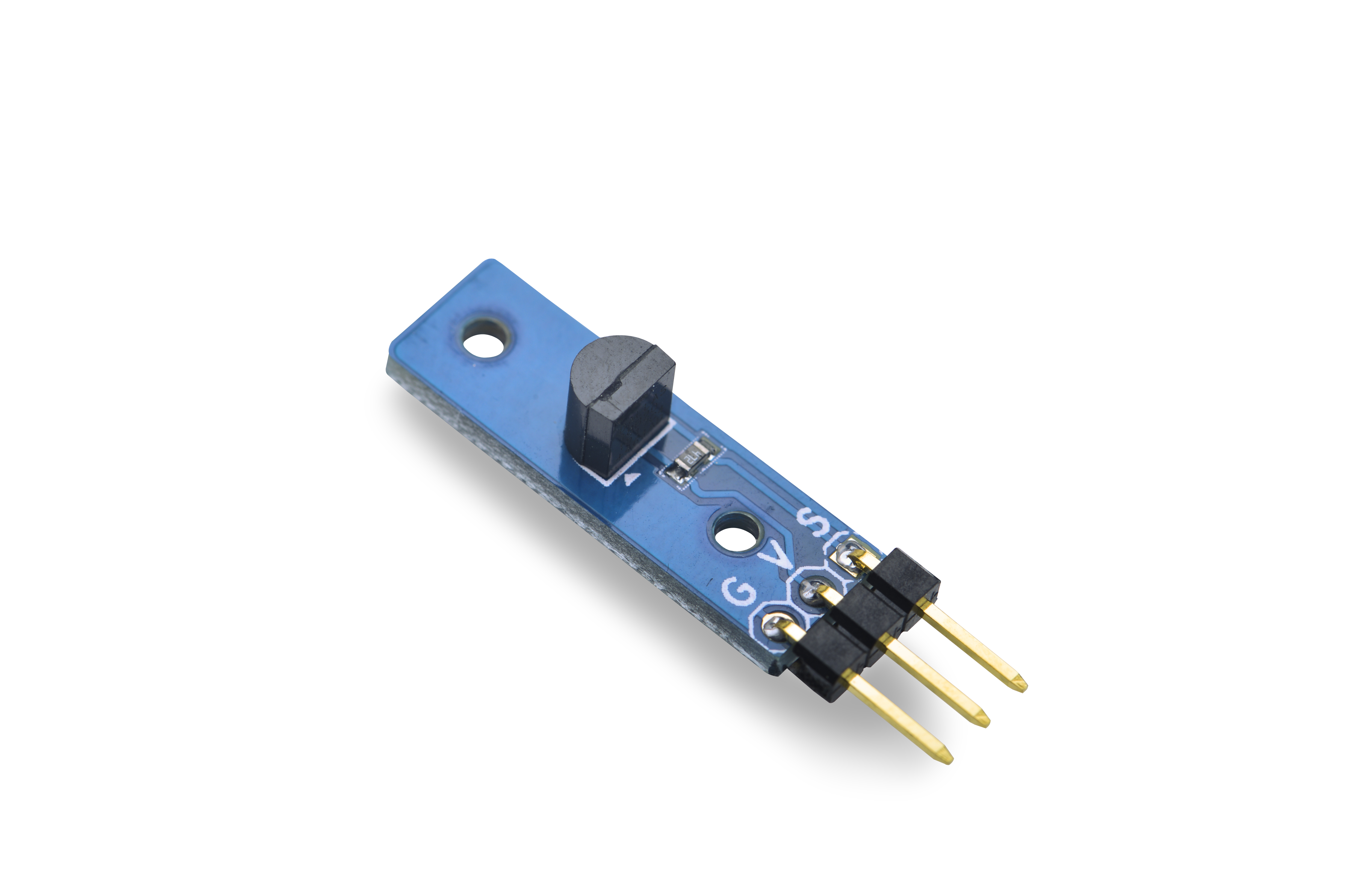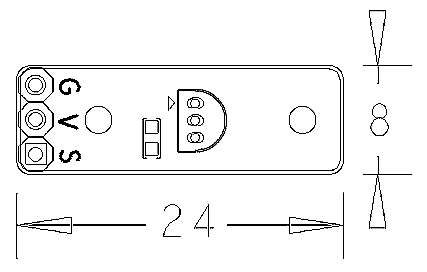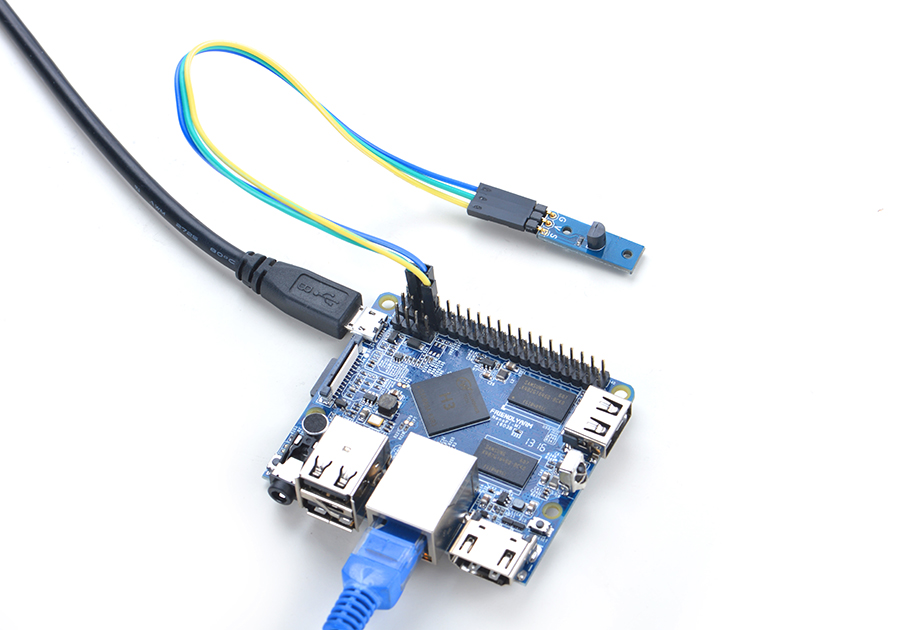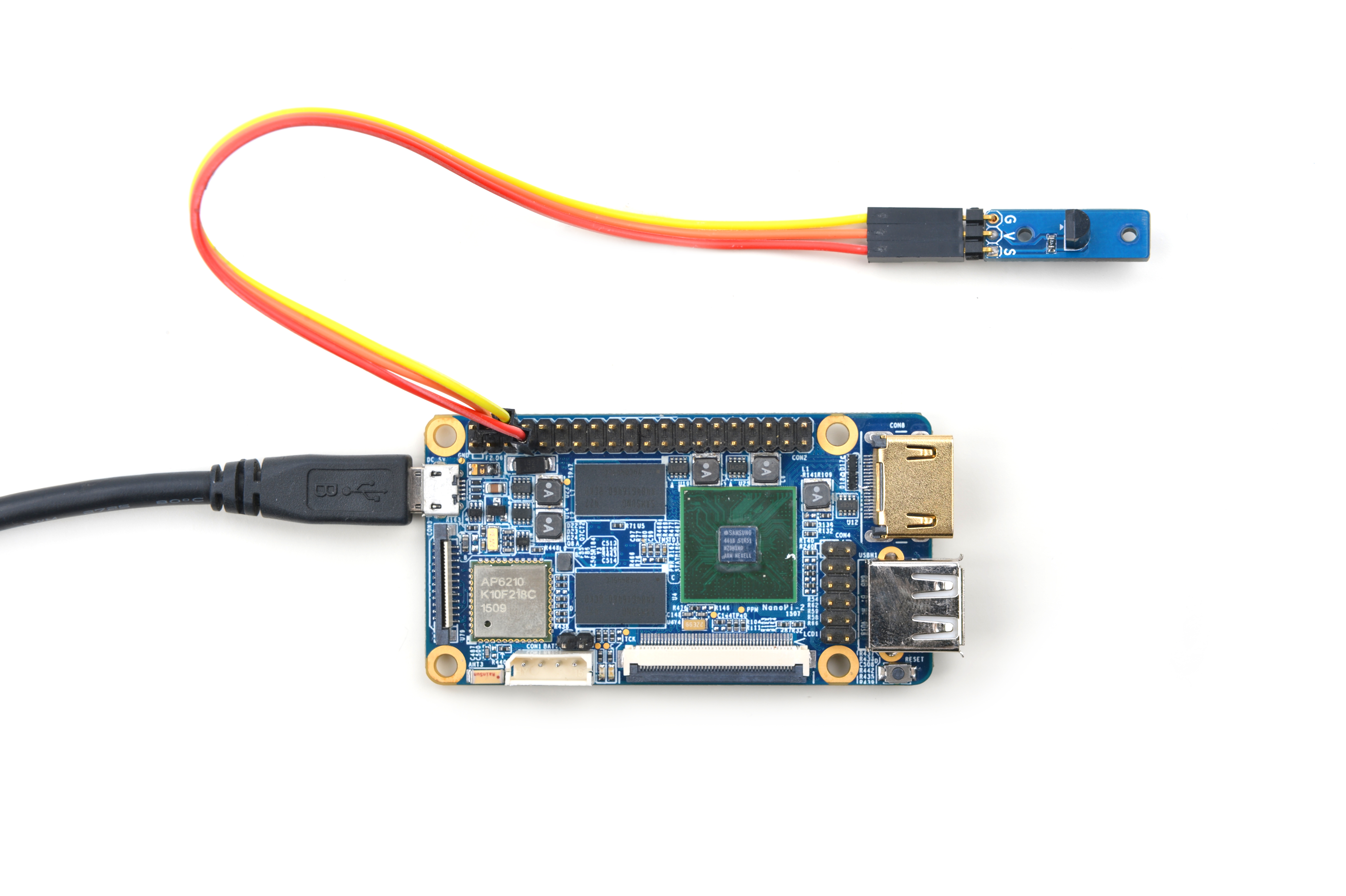Difference between revisions of "Matrix - Temperature Sensor/zh"
(→硬件连接) |
(→连接NanoPC-T2) |
||
| (37 intermediate revisions by 2 users not shown) | |||
| Line 3: | Line 3: | ||
==介绍== | ==介绍== | ||
[[File:TemperatureSensor01.png|thumb|Temperature Sensor]] | [[File:TemperatureSensor01.png|thumb|Temperature Sensor]] | ||
| − | *模块Matrix- | + | * 模块Matrix-Temperature_Sensor用于检测温度。 |
| − | * | + | * 搭载了一颗TO-92封装的DS18B20芯片。从DS18B20读出的信息或写入DS18B20的信息仅需要一根GPIO, 出厂时已经给定了唯一的序列号。 |
| − | + | * 测量范围是-55摄氏度到+125摄氏度,可选9-bit或12-bit,在-10摄氏度到+85摄氏度时可以精确到0.5度,采用一线协议通讯。V对应电源引脚,G对应地引脚,S对应数据引脚。 | |
==特性== | ==特性== | ||
* -55摄氏度到+125摄氏度 | * -55摄氏度到+125摄氏度 | ||
* 一线协议 | * 一线协议 | ||
| − | * | + | * 体积小巧 |
* 2.54mm排针接口,接线方便,通用性强 | * 2.54mm排针接口,接线方便,通用性强 | ||
* PCB尺寸(mm):8X24 | * PCB尺寸(mm):8X24 | ||
| Line 28: | Line 28: | ||
==工作原理== | ==工作原理== | ||
| + | DS18B20低温度系数晶振的振荡频率受温度影响很小,用于产生固定频率的脉冲信号送给计数器1。高温度系数晶振随温度变化其振荡率明显改变,所产生的信号作为计数器2的脉冲输入。计数器1和温度寄存器被预置在-55℃所对应的一个基数值。计数器1对低温度系数晶振产生的脉冲信号进行减法计数,当计数器1的预置值减到0时,温度寄存器的值将加1,计数器1的预置将重新被装入,计数器1重新开始对低温度系数晶振产生的脉冲信号进行计数,如此循环直到计数器2计数到0时,停止温度寄存器值的累加,此时温度寄存器中的数值即为所测温度。 | ||
| − | + | ==硬件连接== | |
| + | ===连接NanoPi NEO/NanoPi NEO Air=== | ||
| + | NanoPi M1和NanoPi NEO以及NanoPi NEO Air的前24Pin引脚定义是一模一样的,所以它们操作Matrix配件的步骤是一样的,并且使用同一份代码。<br> | ||
| − | + | 参考下图连接模块:<br> | |
| − | + | [[File:Matrix-Temperature_Sensor_nanopi_NEO.jpg|frameless|600px|Matrix-Temperature_Sensor_nanopi_NEO]] | |
| − | + | ||
| − | + | ||
| − | + | ||
| − | + | ||
| − | + | 连接说明: | |
| − | + | {| class="wikitable" | |
| − | + | |- | |
| − | + | |Matrix-Temperature_Sensor || NanoPi NEO | |
| − | + | |- | |
| − | + | |S || Pin7 | |
| − | + | |- | |
| − | + | |V || Pin4 | |
| − | + | |- | |
| − | + | |G || Pin6 | |
| + | |} | ||
| − | == | + | ===连接NanoPi M1=== |
| − | + | 参考下图连接模块:<br> | |
| − | + | [[File:Matrix-Temperature_Sensor_nanopi_m1.jpg|frameless|600px|Matrix-Temperature_Sensor_nanopi_m1]] | |
| − | |||
| − | |||
| − | |||
连接说明: | 连接说明: | ||
{| class="wikitable" | {| class="wikitable" | ||
|- | |- | ||
| − | |Matrix- | + | |Matrix-Temperature_Sensor || NanoPi M1 |
|- | |- | ||
| − | |S | + | |S || Pin7 |
|- | |- | ||
| − | |V || | + | |V || Pin4 |
|- | |- | ||
| − | |G | + | |G || Pin6 |
|} | |} | ||
| − | === | + | ===连接NanoPi 2=== |
| − | + | 参考下图连接模块:<br> | |
| − | < | + | [[File:Matrix-Temperature_Sensor_nanopi_2.jpg|frameless|600px|Matrix-Temperature_Sensor_nanopi_2]] |
| − | + | ||
| − | + | ||
| − | + | ||
| − | + | 连接说明: | |
| − | + | {| class="wikitable" | |
| − | + | |- | |
| − | + | |Matrix-Temperature_Sensor || NanoPi 2 | |
| − | + | |- | |
| − | + | |S || Pin7 | |
| − | + | |- | |
| − | + | |V || Pin4 | |
| + | |- | ||
| + | |G || Pin6 | ||
| + | |} | ||
| − | === | + | ===连接NanoPi M2 / NanoPi 2 Fire=== |
| − | + | NanoPi M2和NanoPi 2 Fire的40 Pin引脚定义是一模一样的,所以它们操作Matrix配件的步骤是一样的,这里仅以NanoPi M2为例。<br> | |
| − | < | + | 参考下图连接模块:<br> |
| − | + | [[File:Matrix-Temperature_Sensor_nanopi_m2.jpg|frameless|600px|Matrix-Temperature_Sensor_nanopi_m2]] | |
| − | + | ||
| − | + | ||
| − | + | 连接说明: | |
| − | + | {| class="wikitable" | |
| − | + | |- | |
| − | + | |Matrix-Temperature_Sensor || NanoPi M2 | |
| − | + | |- | |
| + | |S || Pin7 | ||
| + | |- | ||
| + | |V || Pin4 | ||
| + | |- | ||
| + | |G || Pin6 | ||
| + | |} | ||
| − | === | + | ===连接NanoPi M3=== |
| − | < | + | 参考下图连接模块:<br> |
| − | + | [[File:Matrix-Temperature_Sensor_nanopi_m3.jpg|frameless|600px|Matrix-Temperature_Sensor_nanopi_m3]] | |
| − | + | ||
| − | + | ||
| − | + | ||
| − | + | ||
| − | + | ||
| − | + | ||
| − | + | ||
| − | + | ||
| − | + | ||
| − | + | ||
| − | + | ||
| − | + | 连接说明: | |
| − | + | {| class="wikitable" | |
| − | + | |- | |
| − | + | |Matrix-Temperature_Sensor || NanoPi M3 | |
| − | + | |- | |
| − | + | |S || Pin7 | |
| − | + | |- | |
| − | + | |V || Pin4 | |
| − | + | |- | |
| − | + | |G || Pin6 | |
| − | + | |} | |
| − | + | ||
| − | } | + | |
| − | + | ||
| − | == | + | ===连接NanoPC-T2/NanoPC-T3=== |
| − | + | 由于NanoPC-T2跟NanoPC-T3的引脚是一样的,所以连接方式是一样的,这里仅以T2为例,参考下图连接模块:<br> | |
| − | + | [[File:Matrix-Temperature_Sensor_NanoPC-T2.jpg|frameless|600px|Matrix-Temperature_Sensor_NanoPC-T2]] | |
| − | + | ||
| − | = | + | 连接说明: |
| − | + | {| class="wikitable" | |
| − | + | |- | |
| + | |Matrix-Temperature_Sensor || NanoPC-T2 | ||
| + | |- | ||
| + | |S || Pin15 | ||
| + | |- | ||
| + | |V || Pin29 | ||
| + | |- | ||
| + | |G || Pin30 | ||
| + | |} | ||
| − | == | + | ==编译运行测试程序== |
| − | + | 启动开发板并运行Debian系统,进入系统后克隆Matrix代码仓库: | |
<syntaxhighlight lang="bash"> | <syntaxhighlight lang="bash"> | ||
| − | $ | + | $ apt-get update && apt-get install git |
| − | $ git | + | $ git clone https://github.com/friendlyarm/matrix.git |
</syntaxhighlight> | </syntaxhighlight> | ||
| + | 克隆完成后会得到一个名为matrix的目录。 | ||
| − | + | 编译并安装Matrix: | |
<syntaxhighlight lang="bash"> | <syntaxhighlight lang="bash"> | ||
| − | $ | + | $ cd matrix |
| − | $ make | + | $ make && make install |
| − | + | ||
</syntaxhighlight> | </syntaxhighlight> | ||
| − | |||
| − | |||
| − | + | 运行测试程序: | |
| − | + | ||
<syntaxhighlight lang="bash"> | <syntaxhighlight lang="bash"> | ||
| − | $ | + | $ matrix-temp_sensor |
| − | + | ||
</syntaxhighlight> | </syntaxhighlight> | ||
| − | + | 注意:此模块并不支持热插拔,启动系统前需要确保硬件连接正确。<br> | |
| − | + | 运行效果如下:<br> | |
| − | + | ||
<syntaxhighlight lang="bash"> | <syntaxhighlight lang="bash"> | ||
| − | + | The temperature is 27.312 C | |
</syntaxhighlight> | </syntaxhighlight> | ||
| + | 成功读取温度值。 | ||
| − | == | + | ==代码说明== |
| + | 所有的开发板都共用一套Matrix代码,本模块的测试示例代码为matrix-temperature_sensor,内容如下: | ||
<syntaxhighlight lang="c"> | <syntaxhighlight lang="c"> | ||
int main(int argc, char ** argv) | int main(int argc, char ** argv) | ||
{ | { | ||
| − | + | char temperature[BUF_SIZE], modStr[BUF_SIZE]; | |
| − | int | + | int board; |
| − | + | int pin=GPIO_PIN(7); | |
| − | + | ||
| − | if ( | + | if ((board = boardInit()) < 0) { |
| − | + | printf("Fail to init board\n"); | |
| − | + | ||
| − | + | ||
| − | + | ||
| − | + | ||
| − | + | ||
| − | printf("Fail to init | + | |
return -1; | return -1; | ||
} | } | ||
| + | if (board == BOARD_NANOPI_T2) | ||
| + | pin = GPIO_PIN(15); | ||
| + | |||
| + | if (argc == 2) | ||
| + | pin = atoi(argv[1]); | ||
| + | sprintf(modStr, "modprobe %s gpio=%d", TEMP_GPIO_DRIVER_MODULE, pintoGPIO(pin)); | ||
| + | printf("%s\n", modStr); | ||
| + | system(modStr); | ||
| + | system("modprobe "TEMP_DRIVER_MODULE); | ||
| + | sleep(1); | ||
| + | memset(temperature, 0, BUF_SIZE); | ||
if (ds18b20Read(temperature) > 0) { | if (ds18b20Read(temperature) > 0) { | ||
| − | printf(" | + | printf("The temperature is %.3f C\n", atoi(temperature)/1000.0); |
} else { | } else { | ||
| − | printf("Fail to get temperature\n"); | + | printf("Fail to get temperature\n"); |
} | } | ||
| − | + | system("rmmod "TEMP_GPIO_DRIVER_MODULE); | |
| − | + | system("rmmod "TEMP_DRIVER_MODULE); | |
return 0; | return 0; | ||
} | } | ||
</syntaxhighlight> | </syntaxhighlight> | ||
| − | + | API说明参考维基:[[Matrix API reference manual/zh|Matrix API reference manual]] <br> | |
| − | + | ||
| − | + | ||
| − | + | ||
==相关资料== | ==相关资料== | ||
Latest revision as of 08:59, 10 November 2016
Contents
1 介绍
- 模块Matrix-Temperature_Sensor用于检测温度。
- 搭载了一颗TO-92封装的DS18B20芯片。从DS18B20读出的信息或写入DS18B20的信息仅需要一根GPIO, 出厂时已经给定了唯一的序列号。
- 测量范围是-55摄氏度到+125摄氏度,可选9-bit或12-bit,在-10摄氏度到+85摄氏度时可以精确到0.5度,采用一线协议通讯。V对应电源引脚,G对应地引脚,S对应数据引脚。
2 特性
- -55摄氏度到+125摄氏度
- 一线协议
- 体积小巧
- 2.54mm排针接口,接线方便,通用性强
- PCB尺寸(mm):8X24
- 引脚说明:
| 名称 | 描述 |
| S | GPIO |
| V | 电源5V |
| G | 地 |
3 工作原理
DS18B20低温度系数晶振的振荡频率受温度影响很小,用于产生固定频率的脉冲信号送给计数器1。高温度系数晶振随温度变化其振荡率明显改变,所产生的信号作为计数器2的脉冲输入。计数器1和温度寄存器被预置在-55℃所对应的一个基数值。计数器1对低温度系数晶振产生的脉冲信号进行减法计数,当计数器1的预置值减到0时,温度寄存器的值将加1,计数器1的预置将重新被装入,计数器1重新开始对低温度系数晶振产生的脉冲信号进行计数,如此循环直到计数器2计数到0时,停止温度寄存器值的累加,此时温度寄存器中的数值即为所测温度。
4 硬件连接
4.1 连接NanoPi NEO/NanoPi NEO Air
NanoPi M1和NanoPi NEO以及NanoPi NEO Air的前24Pin引脚定义是一模一样的,所以它们操作Matrix配件的步骤是一样的,并且使用同一份代码。
参考下图连接模块:
Matrix-Temperature_Sensor_nanopi_NEO
连接说明:
| Matrix-Temperature_Sensor | NanoPi NEO |
| S | Pin7 |
| V | Pin4 |
| G | Pin6 |
4.2 连接NanoPi M1
连接说明:
| Matrix-Temperature_Sensor | NanoPi M1 |
| S | Pin7 |
| V | Pin4 |
| G | Pin6 |
4.3 连接NanoPi 2
连接说明:
| Matrix-Temperature_Sensor | NanoPi 2 |
| S | Pin7 |
| V | Pin4 |
| G | Pin6 |
4.4 连接NanoPi M2 / NanoPi 2 Fire
NanoPi M2和NanoPi 2 Fire的40 Pin引脚定义是一模一样的,所以它们操作Matrix配件的步骤是一样的,这里仅以NanoPi M2为例。
参考下图连接模块:
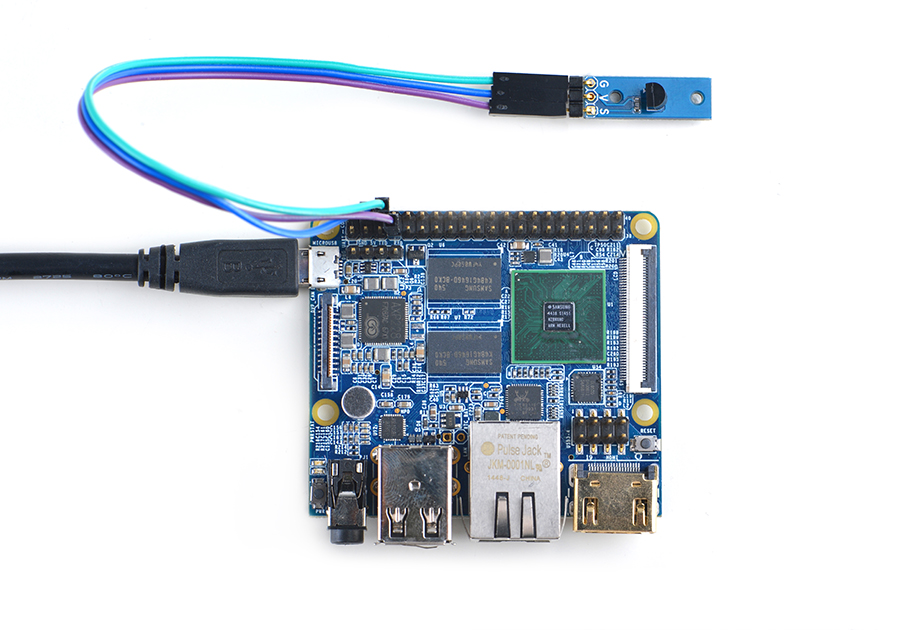
连接说明:
| Matrix-Temperature_Sensor | NanoPi M2 |
| S | Pin7 |
| V | Pin4 |
| G | Pin6 |
4.5 连接NanoPi M3
参考下图连接模块:
Matrix-Temperature_Sensor_nanopi_m3
连接说明:
| Matrix-Temperature_Sensor | NanoPi M3 |
| S | Pin7 |
| V | Pin4 |
| G | Pin6 |
4.6 连接NanoPC-T2/NanoPC-T3
由于NanoPC-T2跟NanoPC-T3的引脚是一样的,所以连接方式是一样的,这里仅以T2为例,参考下图连接模块:
Matrix-Temperature_Sensor_NanoPC-T2
连接说明:
| Matrix-Temperature_Sensor | NanoPC-T2 |
| S | Pin15 |
| V | Pin29 |
| G | Pin30 |
5 编译运行测试程序
启动开发板并运行Debian系统,进入系统后克隆Matrix代码仓库:
$ apt-get update && apt-get install git $ git clone https://github.com/friendlyarm/matrix.git
克隆完成后会得到一个名为matrix的目录。
编译并安装Matrix:
$ cd matrix $ make && make install
运行测试程序:
$ matrix-temp_sensor注意:此模块并不支持热插拔,启动系统前需要确保硬件连接正确。
运行效果如下:
The temperature is 27.312 C成功读取温度值。
6 代码说明
所有的开发板都共用一套Matrix代码,本模块的测试示例代码为matrix-temperature_sensor,内容如下:
int main(int argc, char ** argv) { char temperature[BUF_SIZE], modStr[BUF_SIZE]; int board; int pin=GPIO_PIN(7); if ((board = boardInit()) < 0) { printf("Fail to init board\n"); return -1; } if (board == BOARD_NANOPI_T2) pin = GPIO_PIN(15); if (argc == 2) pin = atoi(argv[1]); sprintf(modStr, "modprobe %s gpio=%d", TEMP_GPIO_DRIVER_MODULE, pintoGPIO(pin)); printf("%s\n", modStr); system(modStr); system("modprobe "TEMP_DRIVER_MODULE); sleep(1); memset(temperature, 0, BUF_SIZE); if (ds18b20Read(temperature) > 0) { printf("The temperature is %.3f C\n", atoi(temperature)/1000.0); } else { printf("Fail to get temperature\n"); } system("rmmod "TEMP_GPIO_DRIVER_MODULE); system("rmmod "TEMP_DRIVER_MODULE); return 0; }
API说明参考维基:Matrix API reference manual
